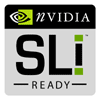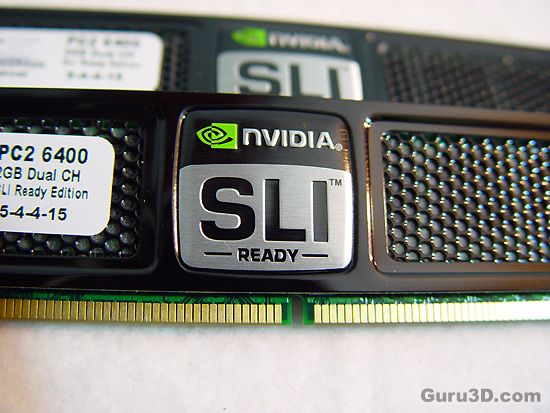Page 4 - SLI memory, RAID
SLI Memory Last year NVIDIA released SLI Ready memory. Personally I find it to be one of the most cool features of this mainboard. I really adore it. DDR2 memory uses an SPD (Serial Presence Detect) chip to store its JEDEC certified timings and setup specifications on. Your mainboard reads this data and can setup the timings and voltages needed according to the memory specifications.
Last year NVIDIA released SLI Ready memory. Personally I find it to be one of the most cool features of this mainboard. I really adore it. DDR2 memory uses an SPD (Serial Presence Detect) chip to store its JEDEC certified timings and setup specifications on. Your mainboard reads this data and can setup the timings and voltages needed according to the memory specifications.
Now a massive chunk of that SPD chip is being written as ZERO; meaning it's largely unused space. Why not do something with that extra space and utilize it for our new products to offer you guys better options and alternatives ?
Since most memory is configured at JEDEC specifications, the standard timings are not exactly enthusiast presets. Most of us know, we can do a heck of a lot more with memory timings and frequencies than the rather safe JEDEC SPD settings your BIOS uses by default.
Once you overclock the system bus, your memory clock will run faster in MHz also. A higher FSB usually means that we'll need slower timings and/or different voltages, that kind of information could be stored into the SPD in several profiles.
So basically, additional non-JEDEC specified timings related towards a certain clock frequency or related to multipliers/dividers/voltages/drive strengths will be stored on that unused SPD space. This way that memory can be setup in a different way with the click of a button, or even better: Detected by your nForce 780i mainboard and set automatically. Now this is why you see NVIDIA slapped all over the memory, SLI Ready is a feature that can be found on the more expensive Series 6/7 NFORCE products from NVIDIA.
So in short: go into the BIOS, and you can tweak memory really easy. It's a reasonably fool proof method of getting the best out of your DDR2 memory with an NFORCE series 680/780 mainboard. Obviously you can manage memory timings and everything related to it manually as well. This is just an extra feature. Look out in the stores for memory with a "SLI Ready" logo and I honestly think this is a great feature.

RAID Storage
nForce 780i offer you six native SATA 3Gb/s drives. Why is that number six important you ask ? Well, this mainboard is RAID compatible (0,1, 0+1, 5). As you can see you can make a dual RAID 5 solution as RAID 5 requires a minimum of three drives. Obviously it is recommended that all drives on the system should be of the same size.
RAID 5 is the version most often recommended as it takes a number of disks, stripes them together, and puts a parity section on each disk. Therefore if one drive went down, the information is still stored on another disk using parity. Next to that Performance is very close to RAID 0 / Striping]
Also I should mention the MediaShield UI, the RAID unit/SATA connections are hot swappable, meaning you can pull out or insert the plug when the system is powered on. The minute a driver fails or will get unplugged the NVIDIA MediaShield sentinel will pop up and show you what drive/connection has gone bad.
The image shows the hard drive connector ports and provides a visual indication of the location and status of the drives as follows:
- Red rectanglered denotes a failed drive.
- Green rectanglegreen denotes a healthy hard drive.
- Yellow rectangleyellow denotes a member of a failed RAID array, but is not the cause of the failure.
- No color rectangleunconnected ports have no visual indication.
And now then there is the power of RAID 5... if one of the drives fails, the system can continue to run by just writing to one drive. Since you have hot swappable drives, you could pull out the bad drive, plug in a new one and the system is back to its normal state. So you have the media shield alerting you what drive is broken, without disabling the system you swap the driver and bam, it's rebuilding the storage array. Effectively you can now setup two RAID 5 units, or just 0, 1, 0+1.
